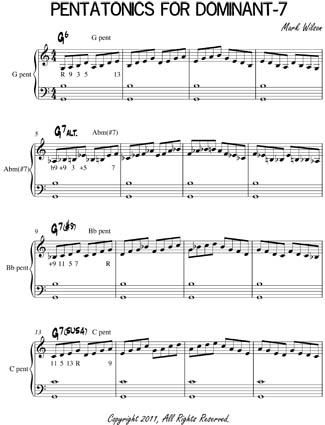« The 'ii V7 I' Chord Progression Pt. 3 with Don Julin |
Main
| V7 Melodic Patterns »
 March 17, 2011 | Going outside with Pentatonics March 17, 2011 | Going outside with Pentatonics
Chief Research Assistant and guest JazzMando columnist, Mark Wilson returns this week to dig us deeply into a fascinating concept of using a very simple familiar musical element, and developing it into something aurally enticing, quite common amongst the Bebop jazz traditionalists. He reintroduces the five not patter we all know as the Pentatonic scale, and shows us how we can supercharge our improvisation over variations of the V7 (Dominant 7th) chord. Mark has included a valuable accompaniment track (MIDI file and MP3) along with a terrific two-page exercise worksheet.
Hold onto your hats!
Going outside with Pentatonics
Mark Wilson
Howdy MandoJazzers!
Almost every mandolinist knows and loves the Pentatonic scale. This lesson takes something you already know and shows you how to apply it in new ways to get different results.
The Pentatonic scale consists of five notes selected from the major scale. The selected notes are the scale root, the 2nd degree, the 3rd degree, the 5th degree and the 6th degree of the major scale (1, 2, 3, 5, 6). We love pents because they sounds like a cross between an scale and an arpeggio. The C Major Pentatonic scale is C, D, E, G, and A. So, this is a good choice to play over a C Major chord.
Lets talk about using Pentatonics to play over a Dominant 7th chord. The term "Dominiant 7th" means a major triad with a flat-7th on top (1-3-5-b7). It occurs naturally as the five chord in a major key. For this exercise, lets continue to talk the key of C Major. C Major contains the following notes: C, D, E, F, G, A, B, C. If you count from the C, the 5th note in the scale is G, so the five chord is a G7 chord.
The G7 chord has the notes G, B, D, F. Thinking back to Pentatonic usage now, lets look at using a G pentatonic scale over this G7 chord. The G pentatonic scale consists of the 1, 2, 3, 5 and 6 degrees in the G Major scale (It is a G Pentatonic, right?), so those notes are G, A, B, D and E. The question to ask here is this: Do any of the notes in the G Pentatonic scale clash with notes in the C Major scale (the scale from which the G7 chord is formed. The answer is no because all the notes in the G pentatonic scale are also in the C Major scale. So this means you can play the G Pentatonic scale over a G7 chord (which we know functions as a five chord in the key of C.) This is all the background.
Here is the meat of the matter: Other Pentatonic scales can be played over a G7 chord, too. Lets take for example a G7(#9) chord. So, here is how you spell a G7(#9) chord: G, B, D, F, A#. The ninth degree in the scale is an A, and we sharp it to make it a #9. Everybody knows this sound as the "Hendrix" chord because Jimi used it in "Foxy Lady."
Enharmonically, an A# is also a Bb. Lets look at the notes in the Bb Pentatonic scale: Bb, C, D, F, and G. All those notes are in the G7 chord except the C, but since the G7 is in the key of C it is okay to play C. And, the Bb Pentatonic scale has an A# (the Bb), which is the G7's #9 note. So you can play Bb Pentatonic scale of a G7 chord. The Bb Pentatonic natuarlly provides the chord tones of the G7(#9) chord.
Other Pentatonic scales can be played over a G7 chord that provide various extensions and alterations to the G7 chord. They are:
1) Ab minor Pentatonic gives a G7(b9,#9,b5,#5) chord because it has the notes Ab, Bb, B, Db and Eb.
2) Bb major Pentatonic gives a G7(#9) chord because it has the notes Bb, C, D, F and G. (remember from above?)
3) C major Pentatonic gives a G7sus chord because it has the notes C, D, E, G and A. The C is the sus4 note.
4) Db major Pentatonic gives a G7(b5,#5,b9,#9) chord because it has the notes Db, Eb, F, Ab and Bb.
5) Eb major Pentatonic gives a G7(#5,#9) chord because it has the notes Eb, F, G, Bb and C.
6) F major Pentatonic gives a G7sus chord because it has the notes F, G, A, C and D. The C is the sus4 note.
All these different chords have their own sound. We've include in this lesson a PDF file link below containing notes and tab of the above examples, and an MP3 file containing a practice track that goes exactly with the written music in the PDF.
Play the practice track and - slowly - figure out and play each pentatonic scale over the chords. Some of them will sound very "outside" but that is good, right? Follow the chart and change pentatonic scale when the chords change. Play it slowly so the new sounds have time to settle into your ears.
Download 2 Page PDF: Pentatonics for Dominant 7ths.

Hear:  MP3 accompaniment track MP3 accompaniment track
Use:  MIDI file accompaniment track MIDI file accompaniment track
Hear scales:  MIDI file scales only MIDI file scales only
Further:
Jazzed Pentatonics
Enhanced Pentatonics; What Goes Up Must Come Down.
Pentatonic revisited
Tetrachordal Approach to Major Scale Modes
Lateral Tetrachords
Posted by Ted at March 17, 2011 9:19 AM

Disclaimer: In the 'Information Age' of the 21st Century,
any fool with a computer, a modem, and an idea can
become a self-professed 'expert." This site does not
come equipped with 'discernment.'
|



